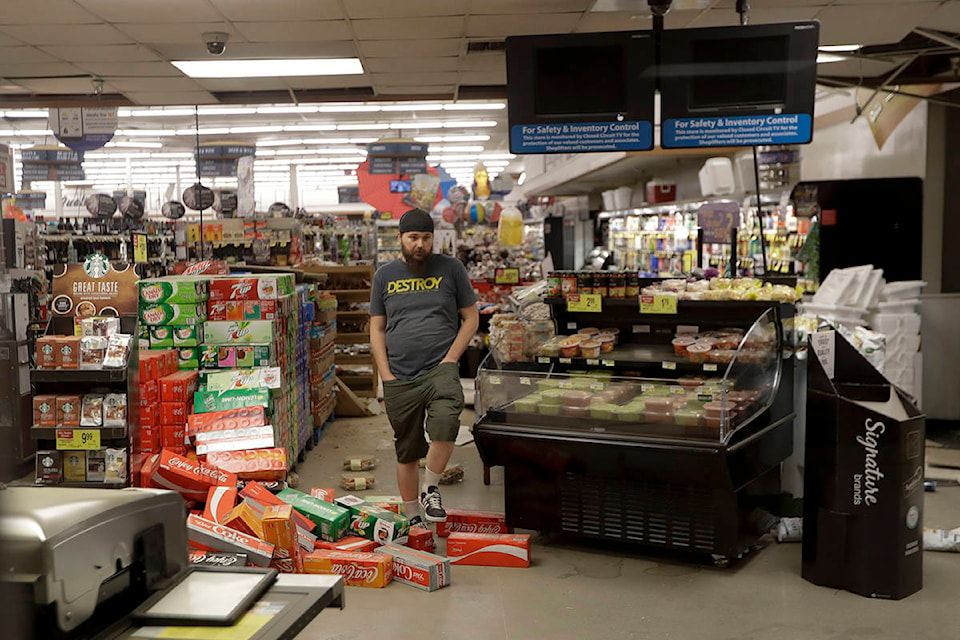The largest Southern California quake in nearly 20 years jolted an area stretching from Sacramento to Las Vegas to Mexico as it cracked buildings, set fires, wrecked roads but only caused minor injuries.
Seismologists warned that large aftershocks were expected to continue for days, if not weeks.
READ MORE: 6.4 magnitude earthquake rattles Southern California
The 7.1-magnitude quake struck at 8:19 p.m. Friday and was centred 11 miles (18 kilometres) from Ridgecrest, the same area of the Mojave Desert where a 6.4-magnitude temblor hit just a day earlier.
Ridgecrest, already trying to recover from Thursday’s earthquake, took the brunt of the damage. Several thousand people there were without power, and there were reports of cracked buildings.
Ridgecrest Police Chief Jed McLaughlin said two building fires — one involving a mobile home — were quickly doused. There were several reports of natural gas leaks, but the lines were shut off. Mark Ghilarducci, director of the California Office of Emergency Services, said daybreak Saturday could show even more serious damage.
Local fire and police officials said they were initially swamped by calls for medical and ambulance service. But the police chief said there was “nothing but minor injuries such as cuts and bruises, by the grace of God.”
For the second time in as many days, Ridgecrest Regional Hospital wheeled patients out of the building, some still hooked to IVs, CNN reported.
Nearby, the tiny town of Trona, with about 2,000 residents, was reported to have at least one collapsed building. Roads were buckled or blocked, and police put out a call for bottled water for residents.
State Route 178 in Kern County was closed by a rockslide and had severe cracking.
In downtown Los Angeles, 150 miles (241 kilometres) away, offices in skyscrapers rolled and rocked for at least 30 seconds.
Andrew Lippman, who lives in suburban South Pasadena, was sitting outside and reading a newspaper when Friday’s quake hit. He calculated it lasted 45 seconds.
“I could see power lines swaying,” he said.
Disneyland in Orange County and Six Flags Magic Mountain in Santa Clarita closed their rides. At the New York-New York hotel in Las Vegas, the Big Apple Coaster swayed as the earth moved.
An NBA Summer League game in Las Vegas was stopped after the quake. Speakers over the court at the Thomas & Mack Center continued swaying more than 10 minutes after it was over.
In Los Angeles, the earthquake rattled Dodger Stadium in the fourth inning of the team’s game against the San Diego Padres. But the game went on, and the Padres won, 3-2.
“Not many people can say they threw a strike during an earthquake,” Eric Lauer, who was on the mound at the time, said later. “My ball, my pitch, started an earthquake.”
“Everyone was jumping over us to leave,” said Daniel Earle, 52, of Playa del Rey, who was sitting with his wife in the stadium’s reserve level. “My wife was holding us, like squeezing. I’m surprised my arm is still here.”
Friday’s quake was followed by a series of large and small aftershocks, including a few above magnitude 5.0.
Southern California can expect more significant shaking in the near future, said Lucy Jones, a seismologist at the California Institute of Technology and a former science adviser at the U.S. Geological Survey.
There is about a 1-in-10 chance that another 7.0 quake could hit within the next week, and chance of a 5.0-magnitude quake “is approaching certainty,” she added.
She said the new quake probably ruptured along about 25 miles (40 kilometres) of fault line and was part of a continuing sequence. The seismic activity is unlikely to affect fault lines outside of the area, Jones said, noting that the gigantic San Andreas Fault is far away.
Gov. Gavin Newsom activated the state Office of Emergency Services operations centre “to its highest level” and announced he had requested that President Donald Trump issue an emergency declaration so the state could receive federal aid.
Earlier Friday, Los Angeles had revealed plans to lower slightly the threshold for public alerts from its earthquake early warning app. But officials said the change was in the works before the Thursday quake, which gave scientists at the California Institute of Technology’s seismology lab 48 seconds of warning but did not trigger a public notification.
“Our goal is to alert people who might experience potentially damaging shaking, not just feel the shaking,” said Robert de Groot, a spokesman for the USGS’s ShakeAlert system, which is being developed for California, Oregon and Washington.
The West Coast ShakeAlert system has provided non-public earthquake notifications on a daily basis to many test users, including emergency agencies, industries, transportation systems and schools.
Construction of a network of seismic-monitoring stations for the West Coast is just over half complete, with most coverage in Southern California, San Francisco Bay Area and the Seattle-Tacoma area. Eventually, the system will send out alerts over the same system used for Amber Alerts to defined areas that are expected to be affected by a quake, de Groot said.
California is partnering with the federal government to build the statewide earthquake warning system, with the goal of turning it on by June 2021. The state has already spent at least $25 million building it, including installing hundreds of seismic stations throughout the state.
This year, Newsom said the state needed $16.3 million to finish the project, which included money for stations to monitor seismic activity, plus nearly $7 million for “outreach and education.” The state Legislature approved the funding last month, and Newsom signed it into law.
Associated Press writers Brady McCombs in Salt Lake City, Juliet Williams in San Francisco, Adam Beam in Sacramento, Stefanie Dazio and Robert Jablon in Los Angeles, Tarek Hamada in Phoenix, Sports Writer Beth Harris in Los Angeles and Associated Press freelancer Jolene Latimer in Los Angeles contributed to this report.
John Antczak, The Associated Press
